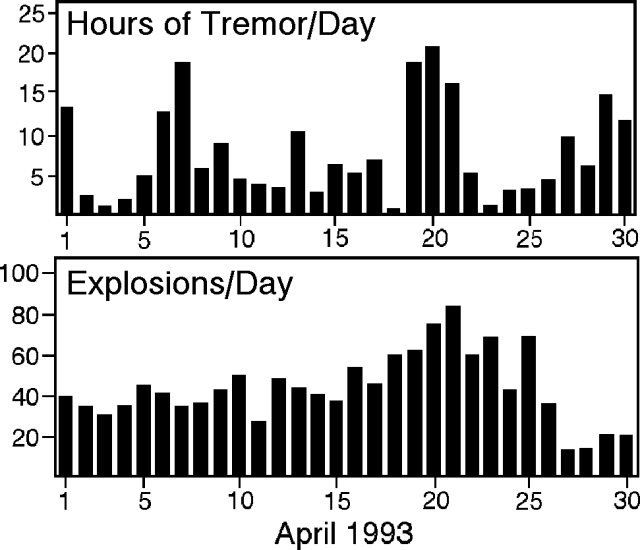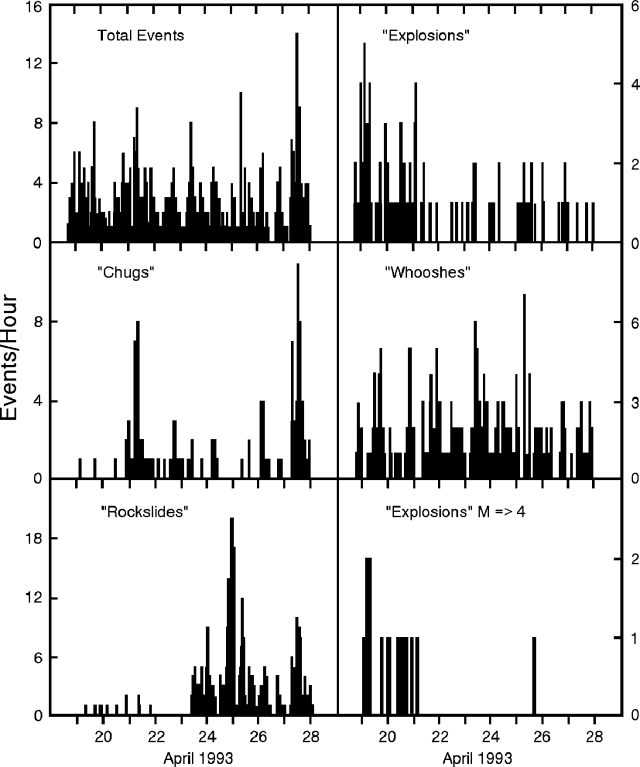Report on Arenal (Costa Rica) — April 1993
Bulletin of the Global Volcanism Network, vol. 18, no. 4 (April 1993)
Managing Editor: Edward Venzke.
Arenal (Costa Rica) Explosions decrease as lava production increases
Please cite this report as:
Global Volcanism Program, 1993. Report on Arenal (Costa Rica) (Venzke, E., ed.). Bulletin of the Global Volcanism Network, 18:4. Smithsonian Institution. https://doi.org/10.5479/si.GVP.BGVN199304-345033
Arenal
Costa Rica
10.463°N, 84.703°W; summit elev. 1670 m
All times are local (unless otherwise noted)
Gas emissions and lava flows continued from Crater C in April, and Strombolian activity vibrated windows of houses in La Palma, ~4 km N. Ash-laden columns were blown E on 15 April, and sporadic pyroclastic flows were observed. The character of the eruption changed on 20 April as the number of explosions decreased while degassing and effusion of lava increased.
The lava flow that started down the SW flank in March remained active. Its W lobe reached 1,050 m elevation and its SW lobe reached 1,000 m elevation. The flow descending the S flank halted at 1,400 m elevation. About the middle of the month a new flow began to descend the SW flank.
A seismograph ~2.7 km NE of the active crater recorded 1,314 explosions in April, an average of 44 explosions/day (figure 55, bottom). The highest daily total was 84 on April 21, and the lowest was 13 on 27 April. Some of the explosions were recorded by a new seismograph network 120 km distant. Tremor was most persistent on 7, 19 and 20 April with 19, 19, and 21 hours recorded respectively (figure 55, top). The tremor frequency was between 1.3 and 2.3 Hz.
 |
Figure 55. Hours of tremor/day (top) and explosions/day (bottom) recorded 2.7 km NE of Arenal. Courtesy of OVSICORI. |
Activity 18-27 April was reported by W. Melson. "Arenal volcano was in continuous eruption. Loud explosions were common 18-19 April, but by 21 April were replaced by frequent chugging and whooshing sounds (figure 56) from summit scoria fountains. These fountains fed a slowly descending, viscous, blocky, highly phyric hypersthene-augite basaltic andesite flow, which spilled over the WSW side of the crater. The flow's advance was accompanied by spectacular avalanches of incandescent blocks from the flow front."
 |
Figure 56. Activity of Arenal, 18-27 April, as observed from Arenal Volcano Lodge, 2.8 km S of the summit craters. "Chug" and "whoosh" events are characterized by their sound. Courtesy of W. Melson. |
Geological Summary. Conical Volcán Arenal is the youngest stratovolcano in Costa Rica and one of its most active. The 1670-m-high andesitic volcano towers above the eastern shores of Lake Arenal, which has been enlarged by a hydroelectric project. Arenal lies along a volcanic chain that has migrated to the NW from the late-Pleistocene Los Perdidos lava domes through the Pleistocene-to-Holocene Chato volcano, which contains a 500-m-wide, lake-filled summit crater. The earliest known eruptions of Arenal took place about 7000 years ago, and it was active concurrently with Cerro Chato until the activity of Chato ended about 3500 years ago. Growth of Arenal has been characterized by periodic major explosive eruptions at several-hundred-year intervals and periods of lava effusion that armor the cone. An eruptive period that began with a major explosive eruption in 1968 ended in December 2010; continuous explosive activity accompanied by slow lava effusion and the occasional emission of pyroclastic flows characterized the eruption from vents at the summit and on the upper western flank.
Information Contacts: E. Fernández, J. Barquero, V. Barboza, and W. Jimenez, OVSICORI; W. Melson, SI; S. McNutt, AVO.

